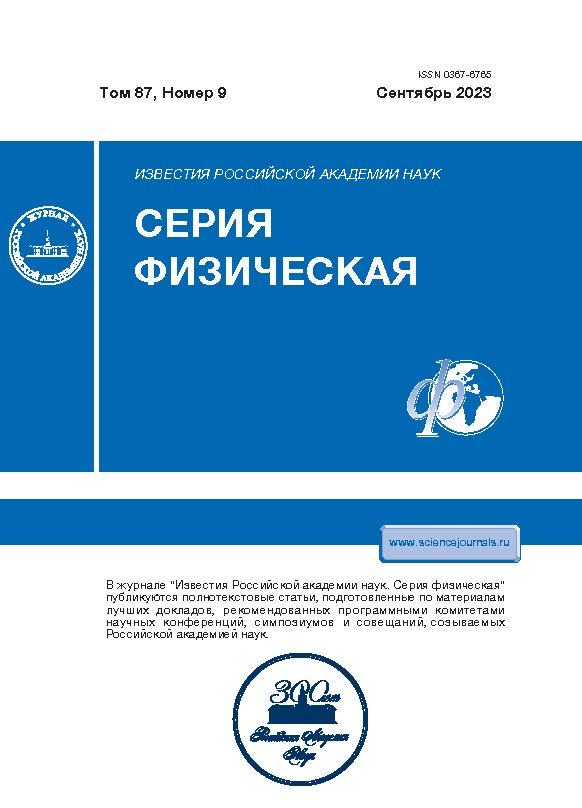Ceramic matrix piezocomposites: microstructural features and dielectric properties
- 作者: Rybyanets A.N.1, Nasedkin A.V.1, Shvetsova N.A.1, Petrova E.I.1, Lugovaya M.A.1, Shvetsov I.A.1
-
隶属关系:
- Institute of Physics, Southern Federal University
- 期: 卷 87, 编号 9 (2023)
- 页面: 1301-1307
- 栏目: Articles
- URL: https://kld-journal.fedlab.ru/0367-6765/article/view/654613
- DOI: https://doi.org/10.31857/S0367676523702290
- EDN: https://elibrary.ru/JELGLO
- ID: 654613
如何引用文章
详细
A new method for the fabrication of ceramic-matrix piezocomposites (CMC) ceramics/ceramics has been developed. Samples of piezoactive PZT/PZT composites with a mass concentration of components from 0 to 50% have been obtained. The study of microstructural and gravimetric features, as well as the dielectric properties of CMC, has been carried out. Finite element modeling and experimental study of CMC properties in the region of dielectric percolation transition have been performed. It is shown that the developed method for manufacturing CMC provides the formation of microhomogeneous composite structures with a uniform distribution of ceramic filler particles in a microporous piezoceramic matrix without the formation of transition regions and additional crystalline phases.
作者简介
A. Rybyanets
Institute of Physics, Southern Federal University
编辑信件的主要联系方式.
Email: arybyanets@gmail.com
Russia, 344090, Rostov-on-Don
A. Nasedkin
Institute of Physics, Southern Federal University
Email: arybyanets@gmail.com
Russia, 344090, Rostov-on-Don
N. Shvetsova
Institute of Physics, Southern Federal University
Email: arybyanets@gmail.com
Russia, 344090, Rostov-on-Don
E. Petrova
Institute of Physics, Southern Federal University
Email: arybyanets@gmail.com
Russia, 344090, Rostov-on-Don
M. Lugovaya
Institute of Physics, Southern Federal University
Email: arybyanets@gmail.com
Russia, 344090, Rostov-on-Don
I. Shvetsov
Institute of Physics, Southern Federal University
Email: arybyanets@gmail.com
Russia, 344090, Rostov-on-Don
参考
- Schmidt S. et al. // Acta Astronautica. 2004. V. 55. P. 409.
- Evans A.G. // J. Amer. Ceram. Soc. 1990. V. 73. No. 2. P. 187.
- Yang B., Chen X.M. // J. Eur. Ceram. Soc. 2000. V. 20. P. 1687.
- Liu Y.G., Jia D.C., Zhou Y. // Ceram. Int. 2002. V. 28. No. 1. P. 111.
- Смотраков В.Г. и др. // Изв. РАН. Сер. физ. 2000. Т. 64. № 6. С. 1220.
- Hwang H.J., Niihara K. // J. Mater. Sci. 1998. V. 33. P. 549.
- Malic B., Kosec M., Kosmac T. // Ferroelectrics. 1992. V. 129. P. 147.
- Xiang P.-H., Dong X.-L., Chen H. et al. // Ceram. Int. 2003. V. 29. P. 499.
- Rybyanets A.N., Rybyanets A.A. // IEEE Trans. UFFC. 2011. V. 58. No. 9. P. 1757.
- Shvetsova N.A., Lugovaya M.A., Shvetsov I.A. et al. // Proc. of the 2015 Int. Conf. “Physics, Mechanics of New Materials and Their Applications”. N.Y.: Nova Science Publishers Inc., 2016. P. 407.
- Rybyanets A.N., Domashenkina T.V., Rybyanets A. // Proc. 19th Int. Symp. ISAF-ECAPD-2010. (Edinburgh, 2010). P. 5.
- Rybyanets A., Motsarenko T., Eidelman A. // Proc. 2007 ICUltrasonics. (Vienna, 2007). P. 1.
- Rybyanets A.N. Advances in porous ceramics. N.Y.: Nova Science Publishers Inc., 2017. P. 159.
- Rybyanets A.N. // In: Advanced materials: manufacturing, physics, mechanics and applications. N.Y.: Springer Proceedings in Physics, 2016. P. 211.
- Gharehnazifam Z., Baniassadi M., Abrinia K. et al. // J. Comput. Theor. Nanosci. 2015. V. 12. No. 6. P. 1010.
- Hori M., Nemat-Nasser S. // Mech. Mat. 1998. V. 30. P. 295.
- Odegard G.M. // Acta Mater. 2004. V. 52. P. 5315.
- Наседкин А.В., Наседкина А.А., Нассар М.Э. // Изв. РАН. Сер. МТТ. 2020. № 6. С. 82; Nasedkin A.V., Nasedkina A.A., Nassar M.E. // Mech. Solids. 2020. V. 55. No. 6. P. 827.
- Oganisyan P.A., Soloviev A.N., Kudimova A.B. et al. // Mater. Phys. Mech. 2018. V. 37. No. 1. P. 16.
- Kudimova A.B., Nadolin D.K., Nasedkin A.V. et al. // Mater. Phys. Mech. 2020. V. 44. No. 3. P. 392.
补充文件













